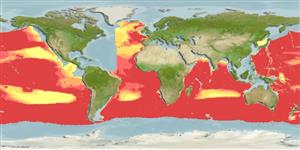Teleostei (teleosts) >
Stomiiformes (Lightfishes and dragonfishes) >
Stomiidae (Barbeled dragonfishes) > Astronesthinae
Etymology: Neonesthes: Greek, neos = new + Greek, esthes = suit, something used to wrap (Ref. 45335).
More on author: Norman.
Environment: milieu / climate zone / depth range / distribution range
Ecology
Marine; bathypelagic; depth range 600 - 1600 m (Ref. 58302). Deep-water
Eastern Atlantic: south of about 3°N, mostly south of 15°S. Across the south Atlantic between 15° and 40°S. One specimen known from 3°S-26°W. Also known from the southern Indian and west Pacific oceans and off Hawaii.
Size / Weight / Age
Maturity: Lm ? range ? - ? cm
Max length : 17.2 cm SL male/unsexed; (Ref. 4465)
Short description
Identification keys | Morphology | Morphometrics
Bathypelagic (Ref. 58302) and mesopelagic species (Ref. 4465, 75154). Minimum depth from Ref. 58018.
Life cycle and mating behavior
Maturities | Reproduction | Spawnings | Egg(s) | Fecundities | Larvae
Gibbs, R.H. Jr., 1990. Astronesthidae. p. 300-307. In J.C. Quero, J.C. Hureau, C. Karrer, A. Post and L. Saldanha (eds.) Check-list of the fishes of the eastern tropical Atlantic (CLOFETA). JNICT, Lisbon; SEI, Paris and UNESCO, Paris. Vol. 1. (Ref. 4465)
IUCN Red List Status (Ref. 130435)
Threat to humans
Harmless
Human uses
Tools
Special reports
Download XML
Internet sources
Estimates based on models
Preferred temperature (Ref.
123201): 2.5 - 8, mean 5.2 °C (based on 930 cells).
Phylogenetic diversity index (Ref.
82804): PD
50 = 0.7500 [Uniqueness, from 0.5 = low to 2.0 = high].
Bayesian length-weight: a=0.00417 (0.00171 - 0.01014), b=3.05 (2.83 - 3.27), in cm total length, based on LWR estimates for this (Sub)family-body shape (Ref.
93245).
Trophic level (Ref.
69278): 3.8 ±0.6 se; based on size and trophs of closest relatives
Resilience (Ref.
120179): High, minimum population doubling time less than 15 months (Preliminary K or Fecundity.).
Fishing Vulnerability (Ref.
59153): Low vulnerability (11 of 100).
